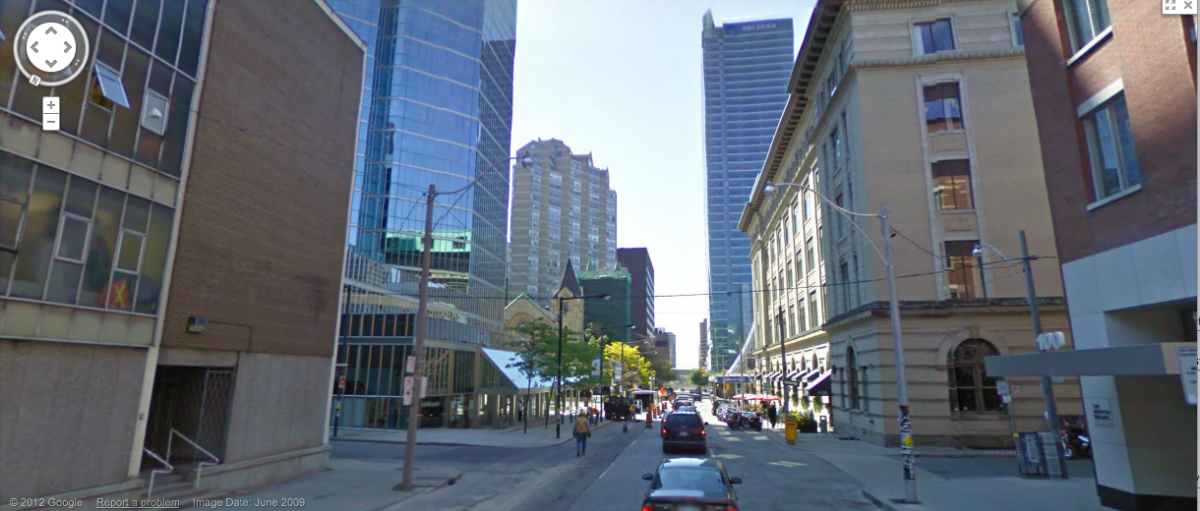Sherlock Holmes has Victorian London.
John Irving has New England.
John O’Hara’s short stories couldn’t work without their small-town Pennsylvania backdrop.
Even fantasy settings need to feel real in order to succeed (think Middle Earth, or Earthsea, or Deep Space Nine). So today we’re going to practise writing stories in which the location is as vivid as any character.
And in this age of Google Maps, Wikipedia, Flickr, Pinterest, a billion hobby blogs and online tourist information sites, there is no excuse for writing a thin, anemic version of any place you can imagine. (Even if you write fantasy, you can base the details in something real.)
The Prompt
Simcoe St in downtown Toronto, ON.
- Pick a place you have never been (preferably somewhere you have a friend – online or otherwise).
- Spend no more than 30 minutes researching it. Use Google Street View, search for blogs based there and ‘listen’ to how its residents talk, scan newspaper archives and obituaries, look at the high school and local library’s websites.
- Set a story in the location you have learned about. Paint a vivid picture of the place; weave it through your action; salt your character’s dialogue with local flavor.
- Then ask your long-distance friend how close you came to getting it right? What bloopers did you make? What slang did you get wrong? Was it too generic? Was it spot on?
Tips
- Remember to tell a story about characters in your location. This is not a travel brochure.
- Write fast. It’s just a fun exercise.
- Make sure your story travels from start to end: don’t just write a scene, make someone or something change between the first word and the last.
The Rules:
- You should use the prompt in your story (however tenuous the connection).
- You must write the story in one 24 hr period – the faster the better.
- Post the story in the comments — if you’re brave enough.
- Find something nice to say about someone else’s story and leave a comment. Everybody needs a little support!
Optional Extras:
Share this challenge on Twitter or Facebook
Some tweets/updates you might use:
Don’t miss my short story: Location, Location, Location! #WriteOnWed #storyaday http://wp.me/p1PnSG-qb
This week’s #WriteOnWed short story prompt is to write in a concrete location! #storyaday http://wp.me/p1PnSG-qb
Come and write with us! #WriteOnWed #storyaday http://wp.me/p1PnSG-qb
See my story – and write your own, today: Location As Character at #WriteOnWed #storyaday http://wp.me/p1PnSG-qb



The Shetland Bus
“Oh Shit, there are German planes coming,” shouted the lookout on the fishing boat.
“All hands on deck.”
The “fishermen” uncovered machine guns from barrels on the deck and fired as they could at the strafing aircraft, while the captain ordered evasive maneuvers.
“Abandon ship. Abandon ship,” Captain Larsen ordered.
Their life boat was lowered and the men jumped into the sea and swam to it. Uninjured men helped their injured comrades. The men rowed for several days to reach land. One of the crew died and was buried at sea. It was March 23, 1943. There was continuous rain, however, and the seas were stormy, providing a rough ride for the men. There was only twilight for the few day-time hours because of the northern latitude and, fortunately, the planes did not return. But, this was no ordinary fishing boat.
On April 9, 1940, Nazi Germany invaded Norway and occupied it until the after the defeat of the German army in 1945. Although the government was under the control of the Germans, there was a strong resistance movement.
The east coast of the Scottish Shetland Island, 225 miles west of Norway became an escape destination for Norwegians threatened by the Nazi’s and for the predominantly young men who comprised the resistance movement. A random assortment of fishing vessels, manned by Norwegian civilians who pretended to be simple fishermen, became known as the “Shetland Bus”. They provide transportation away from Norway for people targeted by the Nazi’s and ferried spies, their equipment, and reports between the west coast of the Shetland Island and the east coast of Norway.
The surviving crew and captain of this particular sunken fishing boat landed at a little village, Sovik, on an inlet at the southern tip of the western peninsula of Norway. Although the gravel beach there was shallow and the landing relatively easy, the men had to find hiding places in the steep hills that rose from the narrow beach. The rain was a nuisance, but the temperatures held above freezing, being moderated by the ocean.
Captain Larson was able to contact a safe person, Lars, one of many resistance fighters along the coast, who helped the men find temporary shelter. After a few days, Lars and the captain determined that the men needed to move to a small island, Tor Holmen, off the coast. Tor Holmen had only one family in residence, so there was little likelihood that they would be discovered before they could be rescued.
The men hid on Tor Holmen for eight days. Then they were transferred to another island, Vigra, and finally to Skorpa, a third island. On Skorpa, they hid in a barn for five more days until they were rescued and returned safely to Shetland Island. Their abandoned life-boat at Sovik now resides in a museum there.